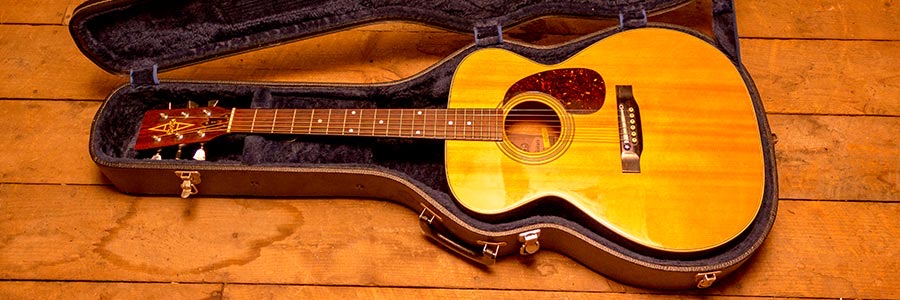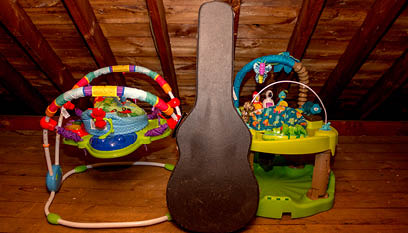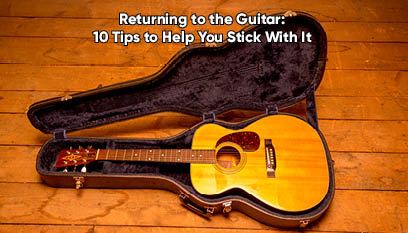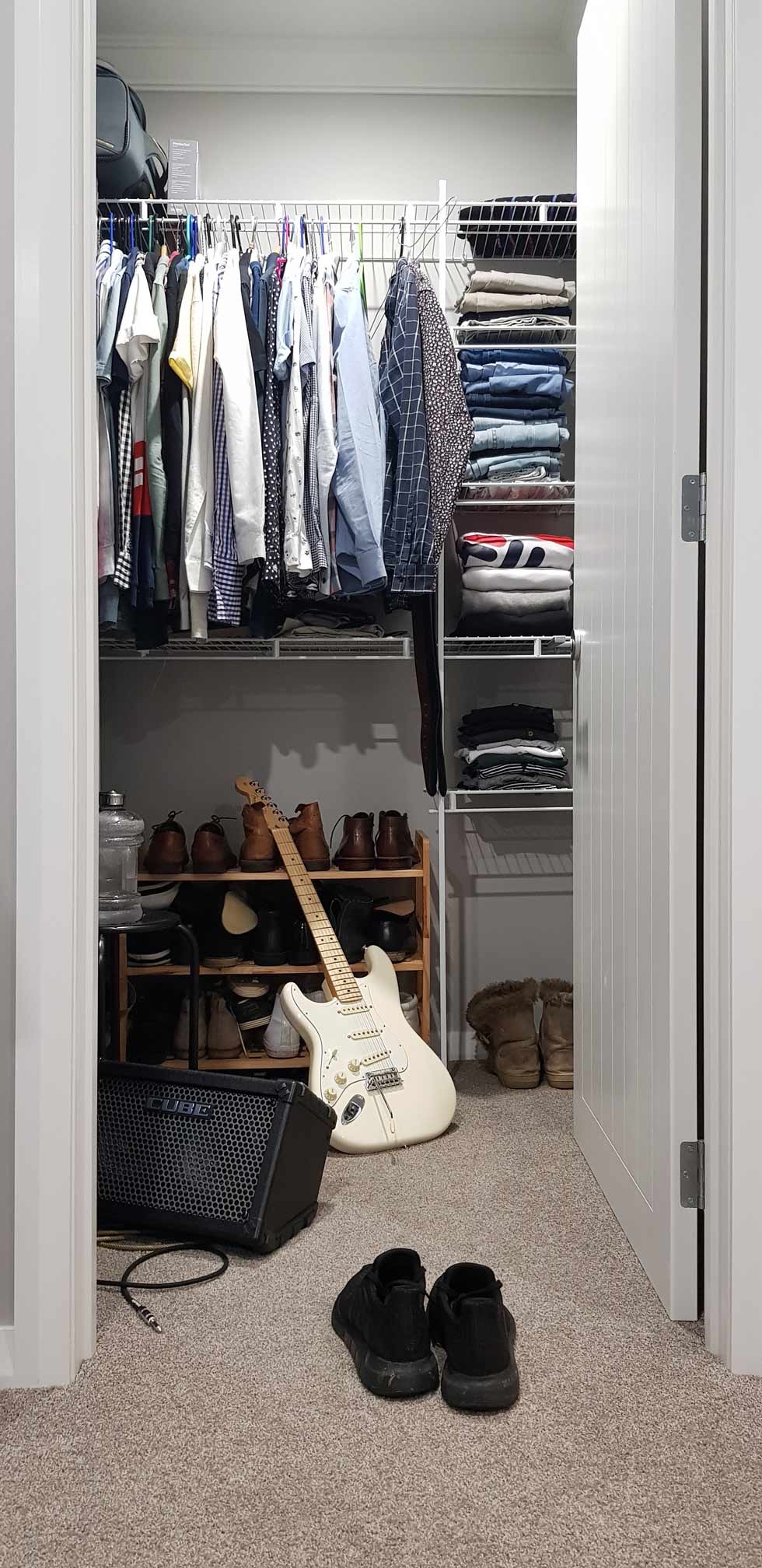 Picking up the guitar after a long hiatus is like getting back in shape after you haven’t worked out in months. This is especially true if you’d been pretty serious before, because the difference in your ability might be painful. “I can’t believe this is so hard!” you’ll think at first. “I would be amazing right now if I’d stuck with it!”
Picking up the guitar after a long hiatus is like getting back in shape after you haven’t worked out in months. This is especially true if you’d been pretty serious before, because the difference in your ability might be painful. “I can’t believe this is so hard!” you’ll think at first. “I would be amazing right now if I’d stuck with it!”
So how do you get back into playing guitar without getting discouraged?
1. Make peace with the gap.
People stop playing music for all kinds of reasons, but in a lot of cases, it wasn’t really intentional. They didn’t quit on purpose — they just woke up one day and realized that they hadn’t picked up their instrument in months or years.
It could be that your band broke up under less-than-ideal circumstances and the idea of continuing to play was not appealing for a while. It could be that your work, academic, or family commitments got in the way. It could be that you had to take a break from playing while you recovered from some kind of injury.Regardless of why you stopped playing, there’s no reason to mourn the time you’ve lost. Don’t hold onto the regret. Treating the break like some kind of moral failing won’t make you a better player, and it could actually hold you back. Whatever the circumstances were, let them go and make a fresh start.
2. Get a guitar if you don’t have one anymore.
Obviously, you’re going to need something to play. If you don’t own a guitar anymore, get one. You don’t have to spend a fortune — just make sure that whatever you get is good quality. Check out my tips for finding a great guitar at a yard sale!
Go buy a guitar while you’re still fired up about playing. You don’t want to spend too much time researching guitar models, because you could risk losing momentum — or going broke on new gear. Returning players can easily succumb to Gear Acquisition Syndrome (GAS) if they’re not careful, so just focus on what a beginner needs to get started. Once you’ve got that, you can focus on rebuilding your gear empire.

Get that guitar out of the attic and back in your hands!
Whether you still have a guitar kicking around or you’ve just bought one, take it to a qualified luthier for a fresh set-up. That will make sure your guitar is comfortable to play and free from annoying issues like high action and sharp frets — both of which can make getting back into playing shape more painful than it needs to be. Nothing will make you give up again like pain!
3. Make time to practice.
Other priorities will always compete for your time, whether it’s kids, work responsibilities, or just piles of stupid laundry! It’s very easy to keep telling yourself you’ll start playing again for real next week.
If you’re serious about your return to playing, you have to carve out time to practice. There’s no way around that. We’re not in The Matrix and you can’t become a kung fu master in an instant (although let’s be honest — that would be sweet!).
You haven’t been playing guitar, so you’ve been using your 24 hours each day for other things. To fit guitar into your life again, something has to shift.
Maybe you can get up a little early and play guitar quietly while the rest of the household is asleep. That could be a nice, peaceful way to start your day (or an aggressive way, depending on the kind of music you play). Maybe you’re not a morning person, but you’re in the habit of scrolling through social media for half an hour before bed. That is the half an hour that could definitely be better spent re-learning guitar.
You can also find ways to fit playing guitar around your other obligations. For example, you could play your acoustic while watching the kids run around the yard. Getting back to that stupid pile of laundry, you can play while you’re waiting for a load of laundry to finish! It doesn’t matter when you practice as long as practice is happening on a consistent basis.
One of our songwriting panelists fits playing into his day by always having a guitar available at work. When his lunch break hits, he jumps in the car and drives a mile or two down the road to a field and gets in some practice. If this works for you, just be sure not to leave the guitar in the car during the workday or overnight. Extreme changes in temperature and humidity can cause catastrophic issues for guitars.
Here’s a little trick that helps defeat procrastination: Leave your guitar out on a stand somewhere you will see it often, instead of buried in some closet. Make it as easy as possible to pick up that guitar and practice.
(In other posts I’ve advised against leaving guitars in the stand for climate control and safety reasons, but I think this is a great time to make an exception. What’s important right now is getting you playing again.)
4. Take advantage of muscle memory.
It might feel like you’re starting over from scratch, but you’re not — playing guitar involves a lot of muscle memory. Your fingers haven’t forgotten how to play. You may be surprised how fast the chord movements come back to you.
Unless you have a job or another hobby that involves a lot of fine motor work with your hands, your fingers will probably be weak for a little while. Just keep at it. Even if you’re just playing scales, that work will help you build up the calluses and the finger strength that you’ve lost.
As I said in the post about practicing quietly, my great-grandfather was a classical pianist, and one of the things he used to do was practice on his “silent piano.” This story inspired one of the tricks I use when I’ve gotten into a non-playing rut and I need to build my calluses back up. I’ll have a guitar in my hands when I’m watching TV. I’m not really playing, but I’m practicing changing chord shapes and running my fingers up and down the strings.
5. Play some songs you used to love playing.
Playing familiar songs will rebuild your confidence and remind you why you love playing guitar.
If you used to write your own songs, your own tunes are a great way to reconnect with your instrument. I always find that my own songs come back to me faster than the tunes I used to cover.
Just go easy on yourself and choose relatively simple, accessible songs. If you used to be able to play Rush’s entire catalog, that’s awesome — but now is not the time to try to bust out “La Villa Strangiato.” Otherwise you could end up feeling defeated, and that’s not the point. This is supposed to be fun, remember?
Those of us who cut our teeth on Ramones or Nirvana have an advantage here in that the material is relatively easy to play. It’s the attitude with which you play it that makes the song sound harder, and I find that attitude usually comes back faster than finger strength.
6. Learn some new songs.
You might find that the old songs you used to play have gotten stale. Maybe they bring up bad memories of past relationships, or you just you don’t connect with them in the same way anymore.
It’s also likely that your taste in music has changed in the interim. Playing those Blink-182 and Barenaked Ladies tunes was fun in 1998, but you need some new material!
Learning new songs can bring fresh energy, and that can be really helpful. You might even discover that techniques that you struggled to master years ago just click now, because you’re approaching the task with a different mindset.
Since you’re going to face a bit of a learning curve for the foreseeable future, this could be a great time to consider trying to play less common styles of guitar, like slide or Dobro.
7. Consider getting a teacher.
A good guitar teacher can assess your skills and help you fill in the gaps so you can get back to where you were (and beyond!) in an organized and efficient way. The teacher can also correct any weaknesses in your technique so you’re not “remembering” how to play the wrong way.
In addition, you may find that the structure of taking lessons and having homework to practice is helpful. Deadlines and accountability do wonders for productivity!
If you’re not going to get an in-person guitar teacher, check out online resources like Justin Guitar.
8. Find ways to bring music and musicians back into your life.
If you stopped playing guitar because “life got in the way,” it’s very likely that you also stopped going to see live music on a regular basis. You need to fix that!
 Go see some live music. Check out a local bar that’s known for live music, or find an open mic at a coffee shop. It doesn’t have to be fancy or expensive, but I promise it will be energizing.
Go see some live music. Check out a local bar that’s known for live music, or find an open mic at a coffee shop. It doesn’t have to be fancy or expensive, but I promise it will be energizing.
If you really like the idea of playing in a group, that can be a fantastic way to continue learning and growing as a musician. Just give yourself some time to rebuild your skills and your confidence before you go looking for people to jam with.
Don’t forget that you can still get inspired by musicians you’re never going to see live. I really love reading biographies of music legends and watching rock documentaries. I find that they always make me want to pick up a guitar.
9. Don’t overdo it. Keep your goals manageable, and log your progress.
Making yourself play guitar for three hours a day when you’re used to playing zero hours a day is a doomed strategy. Don’t try to exhaust yourself into proficiency like some sadistic drill sergeant — it’s not going to work, and you could hurt yourself.
You’re better off practicing for smaller chunks of time when you can really focus on what you’re doing. Promise yourself that you’ll play for a short, defined amount of time every day (say, ten minutes). If you get to the end of those ten minutes and you’re excited to keep playing, great! Consider that bonus time.
Some returning players find that they have more focus and discipline now than they did when they played guitar as teenagers. One way to channel that focus is to keep a practice diary. Months from now, you can flip through that record and see how far you’ve come.
Speaking of which, there’s a 100% chance (due to the nature of the space-time continuum) that you are older than you were when you used to play. That means that you’re likely to get things like sore wrists that you didn’t before. You’ll likely have some day-after soreness for the first couple of weeks.
Be sure to go easy, have some ibuprofen and ice handy, and keep your risk of tendonitis low by doing some finger stretches. Always stop playing before you feel actual pain. For additional tips that may be relevant, check out the post about playing guitar with arthritis.
10. Think about what you like about playing guitar, and why you want to stick with it this time.
When re-learning to play starts to feel frustrating and tedious — and it will, at some point! — think about what drew you back to this hobby. What were you missing?
For me, what keeps me playing when I restart is the ritual of it all. I actually like getting my gear out, cleaning it up, changing strings, and maybe redoing my pedal board. I get reminded of when I was in a band and how much fun it was.
So hopefully I’ve inspired you to get out of the rut and return to playing for good this time. When you’re back up and running, be sure to check out the recommended gear page. I won’t steer you wrong!


